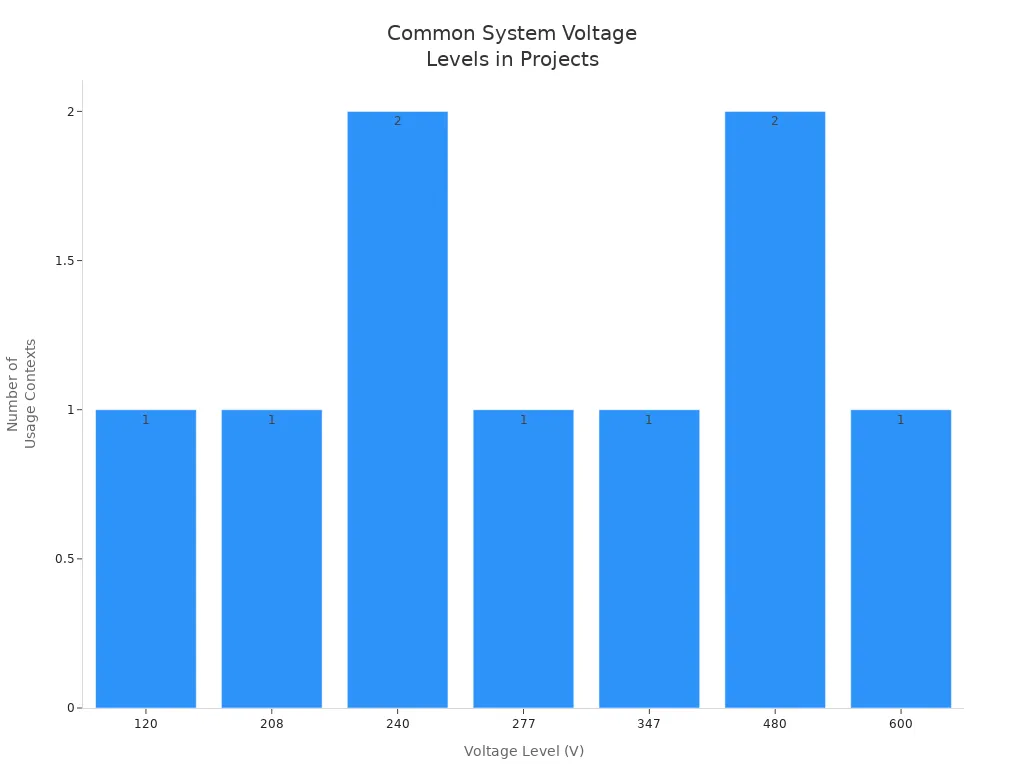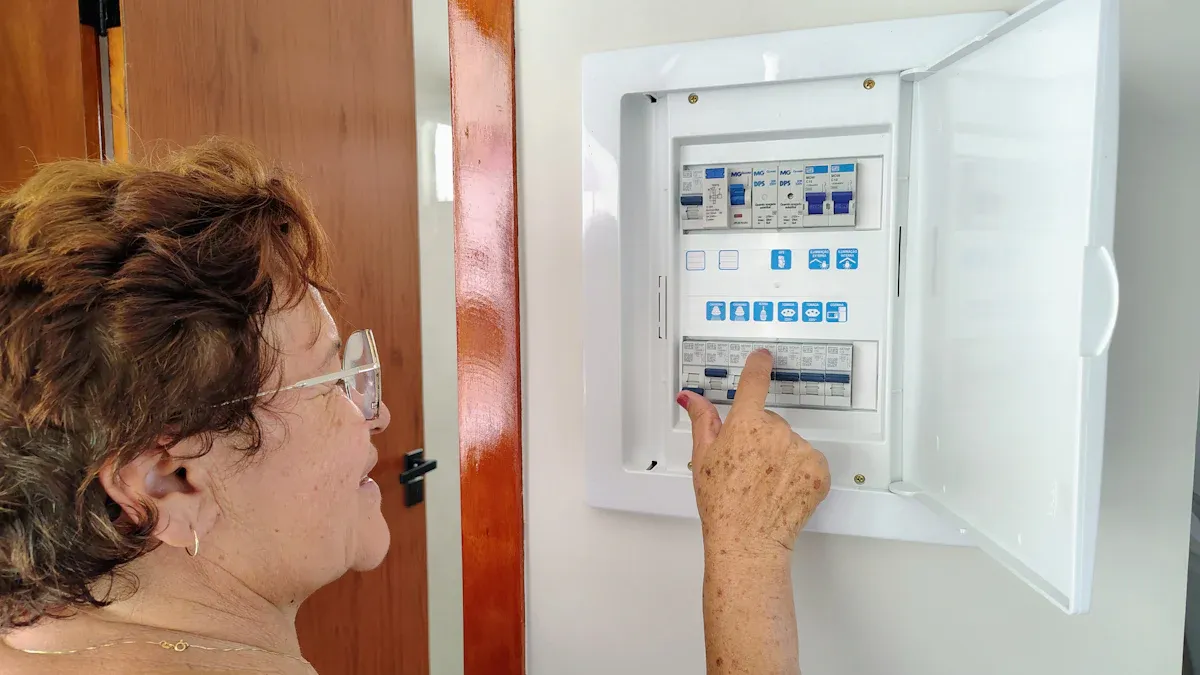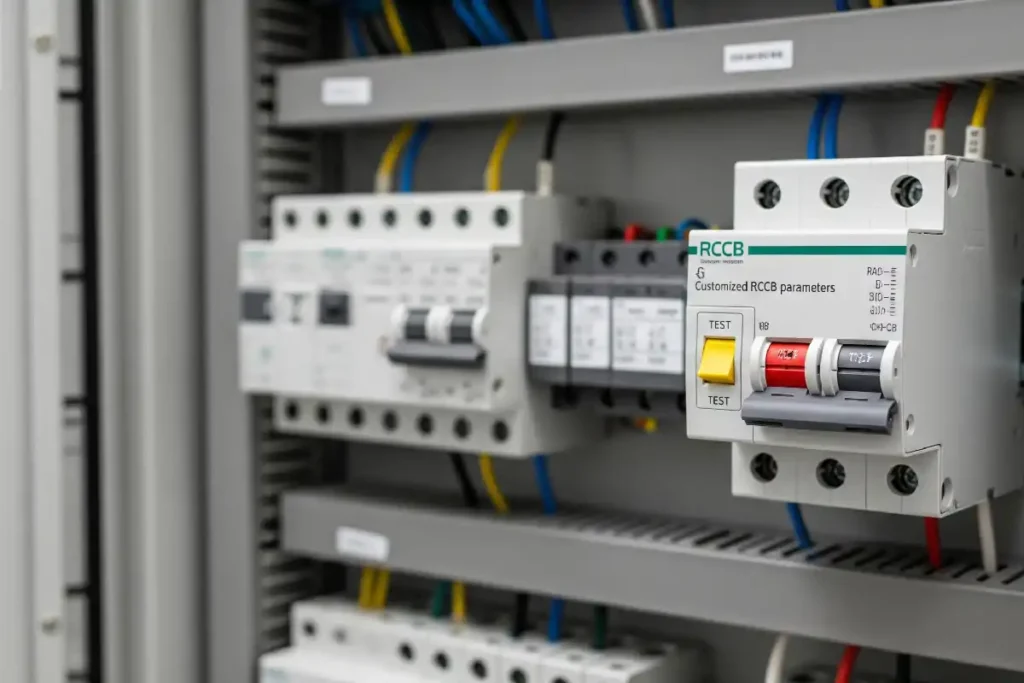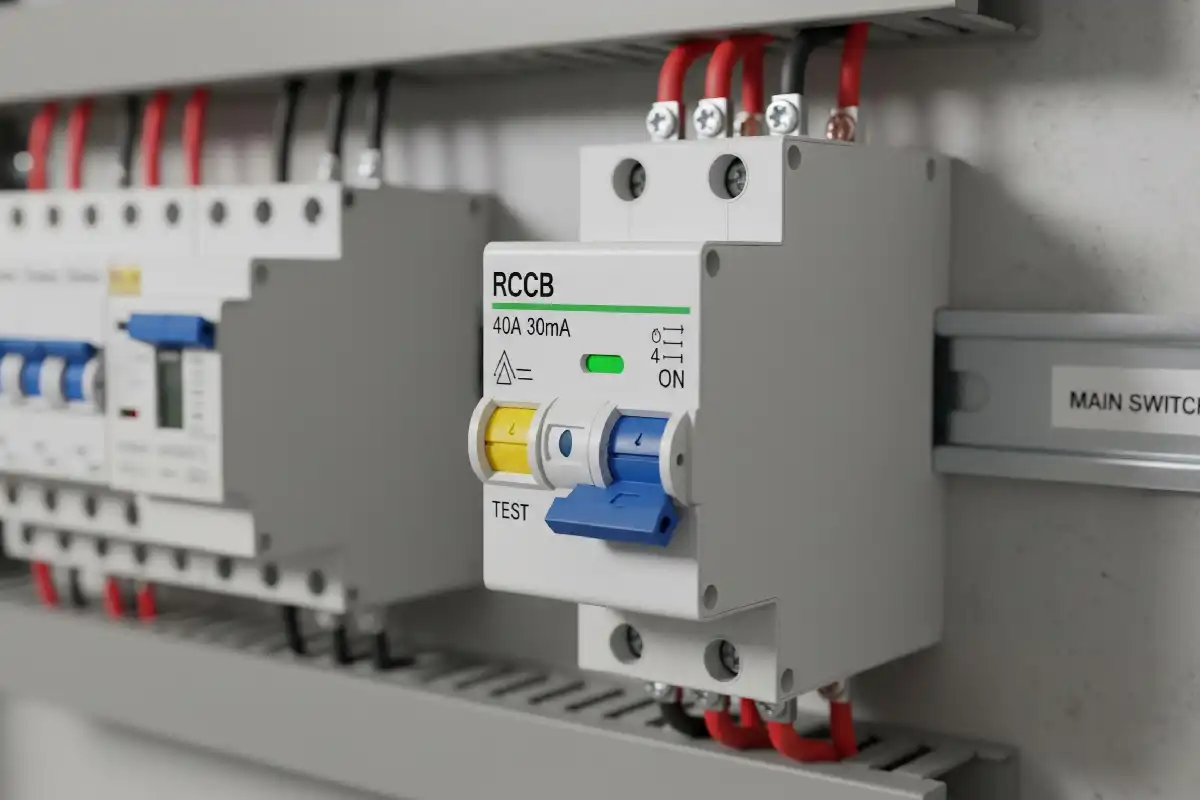To pick the right RCCB parameters, you need to customize RCCB parameters by matching the type, sensitivity, rating, and features to your project’s specific needs and installation environment. Using a product selector tool allows you to customize RCCB parameters effectively, ensuring the best fit for your system. This selector helps you set the right parameters for optimal safety and compatibility.
- Picking the correct RCCB keeps you safe from electrical leaks and indirect contact.
- A 30mA RCCB is very sensitive and provides extra safety in wet locations.
- Additional features like self-testing enhance the RCCB’s reliability and reduce maintenance needs.
A product selector that lets you customize RCCB parameters strengthens your overall safety plan.
Key Takeaways
- First, know your project’s voltage, load, and environment. This helps you choose RCCB parameters that keep things safe and working right.
- Make sure the RCCB’s rated current, number of poles, and sensitivity fit your system. This stops overloads and stops the RCCB from tripping for no reason.
- Choose the right RCCB type, like AC, A, B, or S. Pick it based on the fault currents and equipment in your project. This gives you full protection.
- Use a product selector tool to set RCCB settings easily. You can also add extra features to make things safer and more reliable.
- Always follow safety rules. Test your RCCB often. Ask experts for help if you are not sure. This keeps your system safe and follows the rules.
Identify Project Needs
Before you use a product selector, you need to know what your project needs. This helps you pick the right rccb parameters for safety and good performance.
System Voltage and Load
You must match the rccb to your system’s voltage and load type. Different projects use different voltages and loads. The table below shows some common voltages and where they are used:
| Voltage Level (Volts) | Typical Application / Load Type | Usage Context |
|---|---|---|
| 120 | General household loads, lighting, small appliances | Residential |
| 240 | Larger appliances (ovens, dryers, air conditioners) | Residential, Commercial |
| 208 | Three-phase power for larger equipment and machinery | Commercial, Industrial |
| 277 | Commercial lighting (e.g., troffers) | Commercial |
| 347 | Commercial lighting (HID lamps, metal halide, sodium) | Commercial (Canada) |
| 480 | Large motors, pumps, compressors, commercial lighting | Commercial, Industrial |
| 600 | Heavy machinery, motors, industrial equipment | Industrial (Canada) |
Tip: Homes usually use 120V or 240V. Businesses and factories may need higher voltages.

Choosing the right rccb for your voltage and load stops false alarms and keeps protection strong.
Installation Environment
Where you install the rccb matters. Outdoor and indoor places need different rccb parameters. The table below shows the main differences:
| Parameter | Outdoor Installation Requirements | Indoor Installation Requirements |
|---|---|---|
| Enclosure Type | IP54, IP65, IP67 for dust and water resistance | IP20 or IP40, no water protection needed |
| Temperature Range | -40°C to +70°C for extreme conditions | -5°C to +40°C in controlled spaces |
| Humidity Range | Up to 95% RH for moist or coastal areas | Up to 60% RH in indoor spaces |
| Insulation & Interrupting Capacity | Higher ratings for outdoor/industrial loads | Lower ratings for indoor loads |
Note: Always check the place before using a product selector. This helps you avoid picking an rccb that cannot handle tough weather.
Application Type
You also need to think about what the rccb will be used for. Different jobs need special rccb choices:
- Industrial automation: for smooth work and quick checks.
- Healthcare: for tests and keeping patients safe.
- Consumer electronics: for smart features and connections.
- Automotive industry: for safety and smart systems.
- Aerospace: for accuracy and following rules.
- Energy industry: for making power and keeping the grid steady.
- Large solar and PV systems: for AC/DC sensitivity and strong safety.
- Homes, businesses, factories, and farms: for their own protection needs.
People often make mistakes by picking the wrong current rating or rccb type. To stop this, always check your system’s needs and ask an electrician if you are not sure.
When you know your project’s voltage, environment, and use, you can use a product selector to pick the best rccb parameters for your project.
Customize RCCB Parameters
When you pick an RCCB, you need to make sure it fits your project. You can use a selector tool to help set the right RCCB parameters. This helps keep your system safe and working well. Let’s look at each important parameter and how you can change them for your needs.
Rated Current and Poles
First, choose the right rated current and number of poles. Here is how you do it:
- Find out what kind of electrical supply you have. Use a 2-pole RCCB for single-phase systems. Use a 4-pole RCCB for three-phase systems.
- Pick an RCCB rating that is the same as or higher than your main breaker. This makes sure the RCCB can handle the load safely.
- Set the sensitivity. Most people use 30mA for personal safety. This makes the RCCB trip at a safe leakage current.
The number of poles changes how the RCCB protects your system. Single-pole devices protect one phase. Two-pole and four-pole devices protect both phase and neutral lines. This setup matches your system and gives full protection. Rated current values go from 6A to 630A. Most projects use less than 160A. If your RCCB does not have overcurrent protection, you need a backup device. RCBOs give both protections for extra safety.
Tip: Always match the RCCB rating to your main breaker and system. This stops overloads and keeps protection strong.
Sensitivity and Tripping Current
Sensitivity and tripping current are very important for safety. These settings decide how fast the RCCB reacts to earth leakage. The table below shows common values and where they are used:
| Sensitivity (IΔn) | Typical Use | Application Example |
|---|---|---|
| 30mA | Human protection | Homes, offices, wet areas |
| 100mA | Fire protection | Industrial, commercial buildings |
| 300mA | Fire protection | Large industrial installations |
Pick the right sensitivity and tripping current for your place. High sensitivity (30mA) keeps people safe from shock. Higher values (100mA or 300mA) help stop fires. If you have lots of electronic devices, you might get nuisance tripping. To stop this, keep total leakage below one-third of the RCCB’s tripping value. For example, with a 30mA RCCB, steady leakage should be under 10mA.
Modern systems can have harmonics and mixed-frequency currents. These can change how the RCCB works. If you expect high harmonics, pick a type like SI or F. These types help stop nuisance tripping. This keeps your system safe and stops unwanted trips.
Breaking Capacity and Tripping Time
Breaking capacity and tripping time are also important for safety. Breaking capacity (Icu) is the biggest fault current the RCCB can stop without damage. Most RCCBs have about 100A breaking capacity. This is good for homes and small businesses. Bigger places may need higher ratings.
Tripping time is how fast the RCCB turns off the circuit during a fault. Fast tripping, under 0.1 seconds, lowers the risk of shock and damage. Standards like IEC 60947-2 and BS 7671 set the rules for these settings. Always match breaking capacity and tripping time to your system’s needs. This keeps people and equipment safe and your system running well.
- Breaking capacity lets the RCCB handle faults safely.
- Fast tripping time lowers damage and fire risk.
- Smart breakers can watch these settings and warn you about problems. This helps with maintenance and keeps things reliable.
Advanced Features
Modern RCCBs have new features for today’s needs. These include:
- Microprocessor monitoring for real-time fault checks.
- Adjustable tripping curves for different places.
- Plug-and-play designs for easy setup.
- Built-in communication for remote control and smart grids.
- Programmable settings for custom protection.
These features let you fine-tune sensitivity, tripping current, and more. You can use a selector tool to pick options like extra contacts, remote reset, or programmable tripping times. This makes sure your RCCB fits your project, whether it’s a home, factory, or solar site.
Note: Always check that your RCCB parameters follow standards like IEC/EN 61008 and IEC/EN 61009. This keeps your system safe and makes sure it works with other equipment.
By using a selector to set RCCB parameters, you make a system that fits your project. You boost safety, cut downtime, and get ready for the future.
Select Residual Current Circuit Breaker Type
RCCB Types (AC, A, B, S)
When you pick a residual current circuit breaker, you need to know the types. Each type finds certain fault currents. Picking the right one keeps your system safe and follows the rules.
| RCCB Type | Detection Capability | Typical Applications / Recommended Scenarios |
|---|---|---|
| AC | Detects sinusoidal residual AC currents only | Linear loads such as incandescent lamps, electric heaters, ovens, vacuum cleaners; not suitable for DC or pulsating DC loads; becoming obsolete |
| A | Detects sinusoidal AC and pulsating DC residual currents | Rectified loads like induction cookers, microwaves, dishwashers; electronic devices such as home appliances, office equipment, computers; offers broader protection |
| B | Detects sinusoidal AC, pulsating DC, and smooth DC residual currents | Advanced applications including electric vehicle charging stations, solar power systems, and other DC power source environments |
| S | Provides selectivity and time delay | Used where coordination with other protective devices is needed |
- Type AC RCCBs only work with normal AC power. Use them for simple things like pumps or heaters. They cannot find DC faults. They do not protect new electronics.
- Type A RCCBs find both AC and pulsating DC currents. Pick Type A for circuits with electronics, like LED lights or appliances with rectifiers. This type gives better safety at home or in offices.
- Type B RCCBs find AC, pulsating DC, and smooth DC currents. You need Type B for things like solar panels, electric car charging, or big machines. This type works for all current types and in hard places.
- Type S RCCBs have a time delay. Use them when you need selectivity, like with many breakers in a row.
Tip: Always check what kind of fault current you might have. This helps you pick the right RCCB type and stay safe.
Matching Type to Application
You must match the RCCB type to your project’s needs. First, look at your equipment and where it is used.
- For homes with basic appliances, Type A is usually enough.
- In places with sensitive electronics or mixed loads, Type A or B is safer.
- For solar power, electric car charging, or factories, always use Type B. This type finds all fault currents, even smooth DC.
- If your system has many breakers, use Type S for the main breaker. This stops unwanted tripping and keeps selectivity.
You should also think about the environment. High humidity, dust, or bad air can change how the breaker works. Make sure your choice follows local safety rules like NEC or UL. Test your residual current circuit breaker often to keep it working well.
Note: Picking the right RCCB type keeps people and equipment safe from shock, fire, and harm. It also helps you follow the law and safety rules.
Ensure Compliance and Quality

Standards and Certifications
You must check if your RCCB meets the right standards. These rules help keep people safe and make sure your device works well. The table below shows some important standards and certifications for RCCBs:
| Standard/Certification | Description/Scope |
|---|---|
| IEC | International Electrotechnical Commission standards for electrical safety |
| EN | European Norm standards related to electrical devices |
| CB | Certification Body scheme for electrical products acceptance internationally |
| CE | European Conformity marking indicating compliance with EU safety requirements |
| EAC | Eurasian Conformity mark for products meeting technical regulations in Eurasian Economic Union |
| IEC/EN 60898-1 | Standard for circuit breakers for overcurrent protection |
| IEC/EN 61008-1 | Standard specifically for RCCBs |
| IEC/EN 62423 | Standard for combined residual current devices (RCCBs with overcurrent protection) |
Look for RCCBs that have these marks on them. Following standards like IEC and UL makes your device more reliable. It also helps you sell or use it in more places. Meeting these rules builds trust and helps your project get approved.
Tip: Always ask your supplier for certificates to prove the RCCB meets the standards.
Environmental Factors
Think about where you will put the RCCB. Things like water, dust, and temperature changes can affect how it works. Pick RCCBs made for tough places if your site is very wet or hot. This keeps your system safe and stops it from breaking.
- For outdoor or factory sites, use RCCBs with strong cases and weather protection.
- For indoor places, regular models might be fine, but always check the area first.
Note: The environment can change how your RCCB works. Make sure your choice fits the place where you will use it.
Quality vs. Cost
You need to balance quality and cost when picking an RCCB. You want to keep everyone safe but not spend too much. Here are some ways to do this:
- Choose RCCBs with the right sensitivity and type for your job. Good quality devices find leaks fast and keep people safe.
- Pick models that fit your budget but still meet safety rules.
- Put the RCCB close to the power source and use the right wires. This helps it work better and saves money later.
- Plan to check and test your RCCB often. This keeps your system working and lowers repair costs.
- Compare RCCBs with other safety devices. RCCBs often give the best mix of safety and price.
Remember: Buying good RCCBs and following safety rules keeps people and equipment safe. It also helps you avoid big problems and costs later.
To set RCCB parameters for your project, do these things: First, learn what your system needs. Next, pick the RCCB type that fits your job. Then, choose the right sensitivity and rating. Make sure it works with your voltage and frequency. Get a skilled electrician to put it in. Check and care for your RCCB often.
Safety is most important. Always follow the rules. If your project is tricky, ask an expert or talk to your RCCB maker.
FAQ
What is the first step when choosing RCCB parameters?
First, check your system’s voltage and load type. Look at where you will install the RCCB. This helps you pick the right RCCB for your project. It also helps you stay safe. Always know what your project needs before you start.
How do I select the right sensitivity for my RCCB?
Pick 30mA for homes or wet places to protect people. Use 100mA or 300mA in factories to help stop fires. Always look at your equipment and where it will be used before you choose the sensitivity.
Can I use a product selector to customize RCCB parameters?
Yes, you can use a product selector tool. It helps you set the rated current and number of poles. You can also pick the sensitivity and extra features. The tool guides you step by step to find the best RCCB for your project.
What RCCB type should I use for solar or EV charging systems?
For solar power or electric car charging, use Type B RCCBs. Type B finds all fault currents, even smooth DC. This gives full protection for these special uses.
How often should I test my RCCB after installation?
Test your RCCB every six months. Press the test button to see if it works right. Testing often keeps your RCCB working well and helps you find problems early.
See also
How to choose a household residual current circuit breaker
Breaking Down the Cost of Residual Current Circuit Breakers in 2025
Why Customized RCCB Is the Future of Electrical Safety
What Are Residual Current Circuit Breakers and How Do They Work
Top 8 Residual Current Circuit Breaker Brands for Home Safety




